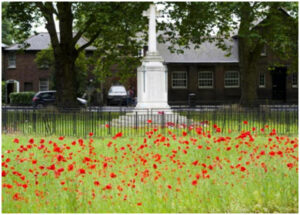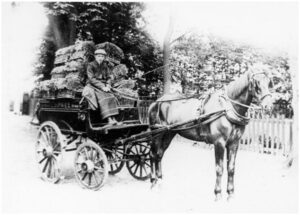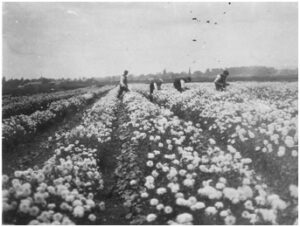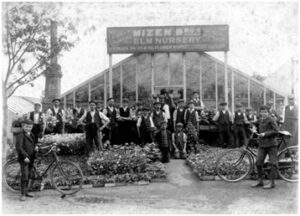Merton Mail
The Society’s e-newsletter was published monthly between June 2023 and December 2024, listing and reviewing MHS and other organisations’ events and reports on local topical issues. Selected articles are reproduced here.
(Nov 23 – Issue 5) He was born in 1922 in Queens Road, Mitcham. His mother died in childbirth with him, and he was brought up by his grandparents. Their house was crowded with their four sons and five daughters. Two of their sons had died in the First World War, and my father was named after one of them, Arthur James Block, who fell at the Somme. He and his brother Edgar, who died in Mesopotamia, are listed on the Mitcham War Memorial. The big story though was the event always simply called ‘The Explosion’. The peppermint distillery factory of W. J. Bush in Batsworth Road was, on the morning of 30th March 1933, boiling a thousand gallons of methylated spirits. There had been a leak and the vapour from this tank was slowly spreading into adjacent houses in Belgrade Road. At some point a spark caused it to ignite.The explosion of that factory caused one fatality, a boy of age twelve named James Addaway. The damage to the houses in Belgrave Road, Bath Road and Queens Road was such that eventually all the residents of that area would be rehoused. It led Mitcham Borough Council to build the housing in New Close and Phipps Bridge Road, later to be also known as Rocky. The year 1933 held a certain fascination for me. I wanted to know more about the explosion, what caused it, the people involved. As I was already interested in photography, I had a slide scanner which could also be used for scanning negatives. I bought a copy of the Mitcham News and Mercury of 1933 on microfilm from the British Library. I think it cost £50. This was before newspapers had become available online such as the British Newspaper Archive. The British Library were a bit puzzled as to why an individual, not a library, was ordering a copy of one of their microfilms. I cut it up into strips that would fit onto the slide reader and scanned them, combining them as PDFs on my computer. Eventually I had a large resource of newspaper articles from 1933. At some point I thought I would upload interesting news articles to Wikipedia. My own career in I.T. of course interrupted these activities and, after several months I went back to Wikipedia to add some more articles, only to find that everything I had put up there had been deleted! Going through the logs of the various discussions from the users who had taken upon themselves to remove my submissions, I found that the basic reason was that as it couldn’t be found anywhere else on the internet, then it couldn’t be true. So, I started my own website using the WordPress blogging system, which was free. I called it Mitcham History Notes because it is a random collection of notes. After 9 years it has grown to just under two thousand posts. The only attempt at organising the website has been to add a log of recent posts on to the introduction page, and to add an index of roads. I hope you find it useful.
My interest in the local history of Mitcham started with my father, Arthur James Brice. He always enjoyed telling me how he grew up in the Rocky of the 1920s, the ‘Star’ School, and his work for Renshaw’s both before and after the war.
(Jan 24 – Issue 7) I scoured the local newspapers and found an advert for a post as a Trainee Junior Draughtsman working for Fry’s Metals Ltd. The post was based at the Flowsolder Equipment Division, which was located at 24 Willow Lane, Mitcham, approximately a mile from where I lived. I was quite good at Maths and Technical Drawing at school so I thought the job was a good opportunity. I submitted an application for the job and shortly afterwards I was granted an interview with George Bartlett, the Personal Manager and John Dalgleish, the Drawing Office Manager at the Flowsolder Division. A job offer followed and I began working in the Drawing Office on the 20th October 1975, earning the princely wage of £20 per week. I continued working in design and development until 1981. Fry’s also sent me to college during this period, studying mechanical engineering, which I thoroughly enjoyed. The Willow Lane site housed a number of different business units of Fry’s, including solder wire production, silver solder manufacture, a lead foundry, the bronze division which also manufactured continuous cast bronze tubing as well as the aforementioned Flowsolder Equipment Division. Although Fry’s were primarily a producer of non-ferrous metals and alloys, they were responsible for an invention that revolutionised mass soldering of printed circuit boards, commonly used in electronic devices, the Wave Soldering Machine. Fry’s trademarked the name “Flowsolder” which becamesynonymous with mass soldering worldwide. The Fry’s Flowsolder Machines were widely sold through agents in many countries, with the North American agent originally being a company called Electrovert who then began to produce their own machines when the original Fry’s patents expired. Lead Industries Group (Fry’s Parent Company at the time) bought a share in Electrovert in 1981 and a new joint venture company, PCB Machinery Ltd, was set up. I was offered a job as a Service Engineer in the new company, complete with a car and expenses. A year later Lead Industries changed the name of the Group to Cookson PLC and the remaining share of Electrovert was purchased. I continued to work for Electrovert until 1984. During March 1985 I became aware of a Technical Sales Representative position becoming available in the Solder Sales department of Fry’s working out of Tandem Works, SW19. I was interviewed by Freddie Thorns and Bob Draisey and offered the job. I was working in the electronics group which was managed by Freddie Thorns. Ken Frith was the industrial/plumbing representative. At around this time Alpha Metals, a US based competitor, was purchased by the Cookson Group and ran alongside Fry’s. I continued working for Fry’s and in 1991 we all moved to new premises in Marlowe Way, Croydon. With the business of Alpha Metals and Fry’s Metals becoming closer knit I moved to the Alpha offices in Tolworth in 1993. The Alpha staff then moved to Marlowe Way in 1995 and we all became Alpha Fry. I worked for Alpha metals out of Marlowe Way until 2001 when sadly I was made redundant. Fry’s Metals Ltd. was a traditional British company with some great characters amongst its employees. It was a great pleasure to learn about such a unique business, such that I still work in solders to this day for a company called DKL Metals Ltd. Set up in 1986 by two ex Fry employees plus an investor, DKL Metals Ltd carry on the Fry’s tradition, manufacturing many of their legacy products.
I lived in Mitcham for most of my early life, having moved from Tooting at the age of four. I left school in mid 1975 and worked casually as a building labourer and in a motorcycle shop for several weeks before my parents suggested that I sought a more permanent form of employment with some prospects.
(Mar 24 – Issue 9) Known as “Peace Day” it was up to the local communities to determine if they wished to celebrate on that day. Certainly, some decided not to and in some places such as Luton and Coventry there were riots and disorder. As far as the Urban District Councils of Wimbledon, Merton and Morden, and Mitcham – which went on to form the London Borough of Merton in 1965 – go, each took part and celebrated the occasion. This article focuses on the celebration in Mitcham. Here it was known as “Victory Day.” Unlike you would expect in July the day started off with a dull but fine morning turning in the afternoon to intermittent showers. After 5 o’clock this rain turned into a steady downpour and lessened by late evening. The day started at 10 o’clock with crowds gathering on the Cricket Green in readiness for a procession through the Borough. There were horse drawn wagons including the horse fire-engine and motor fire-engine, cars, cycles, costumes all decorated and up for and hoping to win a prize later in the day. The bands of the Gas-works and Salvation Army along with Boy Scouts and the Boys and Girls of the Life Brigade also took part. Mr Stephen Chart, later Town Clerk, acted as chief marshal with help from Major Harold Francis Bidder. The local MP Dr. Cato Worsfold was also there taking a great interest as judge of the competitions. The procession, which for a reason unknown changed its route, went via Fair Green, Streatham Lane, Links Road, Longley Road, Colliers Wood High Street, Church Road to the Cricket Green where it came to an end. The Cricket Green had been decorated by local company Pain and Sons. The afternoon was taken up with races that included a boot race (?), a slow bicycle race, running and walking handicaps, and a donkey race. There was a Challenge Cup presented by Major Bidder to the team with highest aggregate score. Despite the rain there was still a large crowd in attendance when the prizes were given out at 6:30pm. It was only the organised dancing at 8 o’clock which had to be abandoned not that it stopped the Gas-works band that continued to play. At this time the temporary war memorial on the Lower Green West was covered by a Union flag with another flying overhead. Guarded on the day by local Volunteers and then the Mitcham Boy Scouts it had an inscription “Honour to our Glorious Dead” at the foot. The memorial also had two lines of text on it. Tributes were added to it at 3 o’clock the first being four little sprigs of forget-me-not, tied with raffia. The memorial that now exists was unveiled in November 1920. (Photo: Mick Taylor) One thing to note is that the 19 July 1919 was a Saturday. In 1919 Saturday was a working day.
Peace Day 1919 in Mitcham
On the 11th November 1918 at 11 o’clock fighting in the First World War stopped. The Armistice brought a ceasefire. It wasn’t until the signing of the Versailles Treaty in Paris on 5thJuly 1919 that the First World War officially ended. The King, at that time George V, issued a proclamation announcing that a Bank Holiday should be held on the 19th July 1919 celebrating the ending of hostilities with Germany. The rain didn’t stop the firework display from Pain and Sons that took place on Three Kings Common starting with a fire balloon that threw out coloured stars, followed by rockets, maroons and flares. There was also a large bonfire on which an effigy of the Kaiser was sat. The day finished near midnight.
The rain didn’t stop the firework display from Pain and Sons that took place on Three Kings Common starting with a fire balloon that threw out coloured stars, followed by rockets, maroons and flares. There was also a large bonfire on which an effigy of the Kaiser was sat. The day finished near midnight.
(April 24 – Issue 10) In Medieval Merton, the nutrient rich soil bordering the River Wandle allowed the Augustinian canons of Merton Priory to grow beans and vegetables for the priory kitchen, plus a range of medicinal herbs to make ointments, poultices and tonics for their infirmary. During the 18th and 19th centuries, north Mitcham was famous for the cultivation of lavender – processed to release fragrant oil for use in perfumes, cosmetics and tonic medicines. The most famous oil distillery was founded at Tamworth Farm in 1749 by William Potter and Ephraim Moore. Other scented crops included Damask rose, bergamot, chamomile and peppermint or “Mitcham Mint.” Victorian pharmacists also relied on Mitcham’s water meadows – then the largest UK cultivation site for the opium poppy. Renowned garden designer, Gertrude Jekyll, is particularly associated with the development of the herbaceous border and worked closely with architect, The John Innes Horticultural Institution also opened in 1910 on part of its namesake’s former Manor House estate in Merton Park. Led by Professor William Bateson, this was the first British research centre for plant genetics. During the interwar era, its experts included pioneering female scientists such as colour variegation specialist, Dorothy Cayley and Biochemical geneticist, Dr. Rose Moncrieff. The Institution developed several superior fruit varieties including the Merton Pride pear, the Merton plum and the Merton thornless blackberry. Perhaps the most successful innovation came in 1938, when the Horticultural Institution’s William Lawrence and John Newell developed the famous John Innes compost formula after hundreds of painstaking trials. Images by kind permission of Sarah Gould © London Borough of Merton:
Green Fingered Heritage
In addition to the green shoots of Spring, April sees the return of National Gardening Week, so this seems an opportune moment to celebrate some aspects of Merton’s horticultural heritage. Watercress was grown in former calico bleaching trenches near Brook Path, Colliers Wood. Frenchman, Louis Dutriez, also grew vast swathes of this crop, at his farm near Willow Lane, Mitcham. Long planks allowed workers to kneel across the water-filled cropping beds without crushing the plants – the men wore thick leather pads to protect their knees. Now regarded as a superfood, watercress or “poor man’s bread” was a common Victorian snack. It was transported by rail from Mitcham Junction, for sale at Covent Garden.
Watercress was grown in former calico bleaching trenches near Brook Path, Colliers Wood. Frenchman, Louis Dutriez, also grew vast swathes of this crop, at his farm near Willow Lane, Mitcham. Long planks allowed workers to kneel across the water-filled cropping beds without crushing the plants – the men wore thick leather pads to protect their knees. Now regarded as a superfood, watercress or “poor man’s bread” was a common Victorian snack. It was transported by rail from Mitcham Junction, for sale at Covent Garden.
 Merton once boasted a number of sizeable market gardens. David Thomson’s 14 acre Wimbledon Hill nursery (founded c.1848 on Earl Spencer’s former kitchen garden), supplied fruit trees, ferns and potted plants. Between 1869 and 1960 the vast Mizen Bros. Elm Nursery at Eastfields grew everything from flowers and vegetables, to mushrooms, salad crops and bedding plants for London’s markets.
Merton once boasted a number of sizeable market gardens. David Thomson’s 14 acre Wimbledon Hill nursery (founded c.1848 on Earl Spencer’s former kitchen garden), supplied fruit trees, ferns and potted plants. Between 1869 and 1960 the vast Mizen Bros. Elm Nursery at Eastfields grew everything from flowers and vegetables, to mushrooms, salad crops and bedding plants for London’s markets.
Thomas Lutyens to create many fine gardens across Britain and the USA. Having been advised to give up embroidery and painting due to declining eyesight, she turned to gardening as an art form. Her sense of colour and encyclopaedic knowledge of plants shaped her gardening style, which is still influential today. Her early 20th century creations included Greystones -19 Mostyn Gardens; “Bowerbank” – 10 The Downs and “Windyridge” – 21 Marryat Road (both in Wimbledon). Merton has also been at the forefront of horticultural science. Between 1910 and the early 1960s, Carter’s Tested Seeds used a 19 acre site in Raynes Park to develop new flower, vegetable and grass varieties. Winners of multiple awards for horticultural excellence, the firm supplied the grass seed for the famous All England tennis courts, Lord’s cricket ground and golf courses across the globe.
Merton has also been at the forefront of horticultural science. Between 1910 and the early 1960s, Carter’s Tested Seeds used a 19 acre site in Raynes Park to develop new flower, vegetable and grass varieties. Winners of multiple awards for horticultural excellence, the firm supplied the grass seed for the famous All England tennis courts, Lord’s cricket ground and golf courses across the globe.
1. Richard Martinne transporting watercress from Dutriez’s farm to Mitcham Junction station.
2. Mizen Bros Elm Nursery c.1912.
3. Harvesting flowers in Mitcham, early 1900s (possibly Mizen site).
4. Carter’s Tested Seeds c.1967
 MERTON HISTORICAL SOCIETY
MERTON HISTORICAL SOCIETY